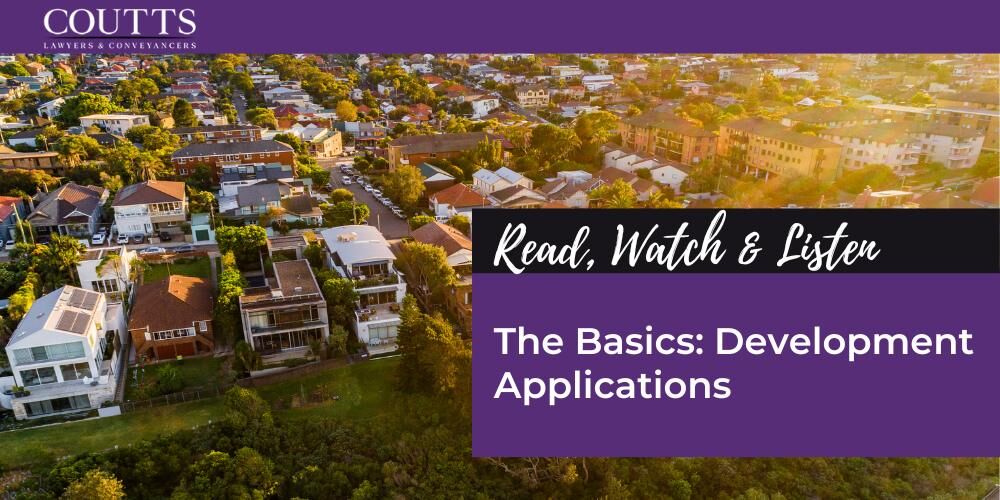KEY TAKE-OUTS:
Before you get started with a Development Application read on to understand:
- The process
- What you need to lodge a Development Application
- The costs
- What your options are if your Development Application is refused
A development application must be submitted to Council, for any development that requires development consent under a Local Environmental Plan (LEP) or State Environmental Planning Policy (SEPP), excluding the Exempt and Complying Development SEPP.
Pre-lodgement
To lodge a development application, you will need to:
- Consider the planning controls relevant to the property. These can include Local Environmental Plan, Development Control Plan, State Environmental Planning Policies
- Have your plans prepared
- Obtain any expert reports that may be required
Plans
The plans required will typically include:
- architectural plans
- survey plans and reports
- landscape concept plans
Reports
The types of reports that may be necessary will depend on the development you are undertaking and any additional restrictions which apply to your property. Some reports that may be required include, but are not limited to:
- Statement of Environmental Effects
- Heritage Impact Statement
- Traffic and Parking Assessment Report
- Biodiversity Development Assessment Report
- Waste Management Plan
- BASIX certificate
- Bushfire Assessment Report
Costs
The costs involved in preparing and lodging a DA can include:
- The DA fee, including the cost of referral to State Government agencies, such as The Rural Bushfire Service in the case of bushfire prone land
- The construction certificate fee and fees incurred in the building process including inspections, engineer’s certificates etc
- Development contributions payable for State and local services
- Conditions that may be imposed by the council such as bonds to cover damage to roads, environmental clean ups, or dilapidation surveys of attached properties
- Water and other service connections
Once you have all the plans and reports required you can finalise and lodge your DA.
Notification period and administration
Once you have lodged the DA, your file will be allocated to an assessment officer.
The landowners of neighbouring and surrounding properties will be notified and they will be given a period of time to make submissions concerning the DA. This period is generally 14 days.
If referrals are required to any State agencies such as Rural Fire Service for concurrence or internal referrals to allow comments on different environmental issues. The relevant agency generally must give written notice of their decision within 40 days of receiving the DA from the Council.
Once the above notification period and referrals have ended the DA will be assessed.
Assessment
In assessing a DA, the Environment Planning and Assessment Act (EP&A Act) requirements must be met by Council.
Under section 4.15 of the Act, the following points must be considered:
All plans and policies that apply – SEPPs, LEPs, DCPs (as outlined in Part 1 of this guide)
- Impacts of your proposal on the natural and built environment and the social and economic impacts in the locality
- The suitability of your site for your proposal (e.g. physical characteristics, availability of access and services)
- Any submissions (such as from neighbours or other groups)
- Any comments or agreements/approvals from any NSW Government agency
- The broader public interest
During this period the Assessment Officer may request additional information. If additional information is requested then the timeframe for a decision may be ‘stopped’ until the additional information has been provided. Once the assessment officer has the additional information the timeframe will commence again. This is called the ‘stop the clock’ provision.
Depending on the type of development a decision may be given within 40 to 90 days commencing from the date the DA was lodged.
Determination
The DA will then be determined. The outcome of determination will be one of the following:
- Granted, with conditions
- DA Refusal
- Deferred Commencement Consent
Typically, you will have 5 years to commence works in accordance with the approval issued, subject to obtaining a Construction Certificate.
What if you are not satisfied with the outcome?
You can seek a review of the decision or lodge an appeal.
Section 8.2 Review
Under the Environmental Planning and Assessment Regulation 2021 an application for review (Section 8.2 Review) can be lodged as follows:
- For a determination of a modification application within 28 days of the determination; or
- A decision by a council to reject and not determine a development application within 14 days after you receive notice of the decision.
The Section 8.2 Review does not apply to a complying development certificate, designated development or Crown development.
Appeal
Following notification of the decision by the Council, an appeal to the Land and Environment Court can be lodged within 6 months of the date of the decision or the date of deemed refusal.
After Development Approval
Your DA was granted, with conditions and now you want to get on site and start building.
First, you will need to review the conditions of the Determination of Development Application for the conditions that need to be satisfied before you can commence construction. These conditions will include as a minimum:
- Obtain a Construction Certificate (CC)
- Appoint a Principal Certifying Authority (PCA) is to be appointed to monitor the construction
- Give two days’ notice must be given to Council and the PCA before you commence work
- Satisfy any conditions required prior to commencing work
The CC includes detailed building plans and engineering details and specifications. These plans contain significantly more information than the approved DA plans. These plans will allow the builder to work directly from them and they must be consistent with the Development Approval.
If you run into challenges in the Development Application process and need assistance understanding the planning law framework please reach out to our Environment and Planning Law team.
For further information please don’t hesitate to contact Coutts Lawyers.
This blog is merely general and non-specific information on the subject matter and is not and should not be considered or relied on as legal advice. Coutts is not responsible for any cost, expense, loss or liability whatsoever to this blog, including all or any reliance on this blog or use or application of this blog by you.



